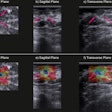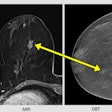
Expert second-opinion review of gynecologic oncologic MR images is important as it can affect treatment. Approximately 20% of MRIs had discrepancies between initial and second-opinion interpretations in a new study, which would have affected management, including preventing surgery.
More than 400 second-opinion MRI interpretations by gynecologic oncologic radiologists were compared with initial outside reports. Two gynecologic surgeons, who were blinded to the reports' origins, reviewed all cases with discrepancies between initial and second-opinion MRI reports and found the discrepancies would have led to a change in management in approximately 20% of cases, including preventing unnecessary surgery, according to a team led by Dr. Yulia Lakhman from the radiology department at the Breast and Imaging Center at Memorial Sloan Kettering Cancer Center in New York City.
The results indicate second-opinion review of gynecologic oncologic MRI by subspecialized radiologists can impact patient care, allowing for more informed medical decision-making, the researchers wrote (European Radiology, 22 October 2015).
"In conjunction with previous studies in other imaging disciplines, our findings support the notion that subspecialty training and focused expertise influence patient management in a setting of multidisciplinary, disease-specific, team-based care," they added. "Furthermore, second-opinion consultations should be viewed as a valuable and reimbursable clinical service."
Why second-opinion imaging matters
Rates of disagreement between initial and second-opinion imaging interpretations have been examined in a number of studies in fields such as oncologic imaging, abdominal imaging, neuroradiology, pediatric imaging, and emergency radiology. Some emphasized the frequency of minor and major discrepancies rather than their impact on patient care as determined by referring clinicians.
Lakhman's team sought to determine the added value of second-opinion review of gynecologic oncologic MRI examinations by gynecologic oncologic radiologists, as assessed by treating physicians, because there is limited literature in this area and gynecologic MRI scans are commonly interpreted by general body radiologists, who may have limited subspecialty training in gynecologic MRI.
The researchers included 469 second-opinion MRI interpretations by gynecologic oncologic radiologists that were retrospectively compared with initial outside reports. Two gynecologic surgeons, who were blinded to the reports' origins, reviewed all cases with discrepancies between initial and second-opinion MRI reports. They recorded whether these discrepancies would have led to a change in patient management defined as a change in treatment approach, counseling, or referral. They used histopathology or minimum six-month imaging follow-up to establish the diagnoses.
Second-opinion review of MR images would theoretically have affected management in 94 of 469 (20%) and 101 of 469 (21.5%) patients for surgeons one and two, respectively. Specifically, second-opinion review would have theoretically altered treatment approach in 71 of 469 (15.1%) and 60 of 469 (12.8%) patients for the two surgeons, respectively.
| Treatment changes | |||
| Preventing unnecessary surgery | Changed surgical procedure type/extent | Changes in counseling | |
| Surgeon 1 | 35 patients (7.5%) | 19 (4.1%) | 92 patients (19.6%) |
| Surgeon 2 | 31 patients (6.6%) | 12 (2.5%) | 101 patients (21.5%) |
Second-opinion interpretations were correct in 103 (83%) of 124 cases with clinically relevant discrepancies between initial and second-opinion reports.
"We hypothesize that the focused, subspecialty expertise of the radiologists who performed the interpretations largely accounts for considerable differences in interpretations," they wrote. "This proficiency has likely developed as a result of repeated exposure to a large volume of cases with similar clinical findings and questions, a concept that is supported by prior literature, including [gynecological] imaging."
Limitations
The authors noted several study limitations. The study design was retrospective, potentially leading to a number of selection biases. For instance, only gynecologic oncologic MRI examinations submitted for second-opinion review were included, so it is possible the rate of clinically relevant discrepancies would have been different if all outside gynecologic oncologic MRI studies were submitted for review.
Also, the distinction between clinically important and unimportant discrepancies is subjective, the authors added.
"We tried to limit this concern by recruiting two senior gynecological oncologic surgeons to evaluate all deidentified MRI reports with any discrepancies between initial readings and second-opinion interpretations," Lakhman and colleagues wrote.
The study results indicate second-opinion review of gynecologic oncologic MRI by subspecialized radiologists can impact patient care, allowing for more informed medical decision-making and should be viewed as a valuable and reimbursable clinical service, the authors concluded.



















